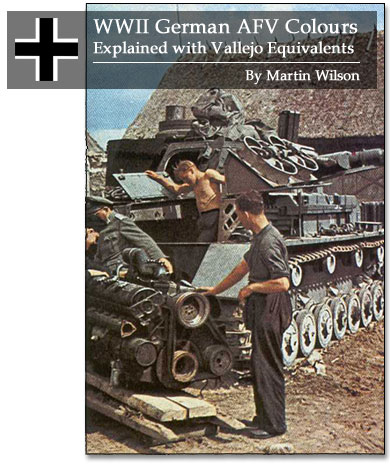1⁄35WWII German AFV Colours
 |
All Vallejo paint reference comes from the Model Colour range (M/C). Numbers
with the prefix # are approximations as no definitive match exists. Model Air is
indicated by M/A.
Before the outbreak and during the war in Europe and the East, the German
Wehrmacht was regulated by Army Memorandum, (Heeresmitteilung), issued by the
OKH, Oberkommando des Heeres (Army High Command), regarding the standard and
regulation paints to be used on new and re-commissioned vehicles at various
times throughout the war. Unfortunately there seems to be little in the way of
"norm" when it came to captured foreign armour. It appears as though some
captured armour was re-painted in the standard scheme of the time, and some of
it was not. There is documentary evidence to prove both sides of the arguement.
I strongly believe that the modeller has, again, artistic licence.
Vehicle base colours were permanently applied at the factory and were matched
with the various "swatches" supplied with the Heeresmitteilung.The factories
were the first to implement any base colour changes. When Dunkelgelb (dark
yellow) was introduced in February 1943 as a base colour, the new regulations
were adhered to and any newly manufactured vehicle was immediately re-sprayed at
the factory with the new regulation colour (RAL). Camouflage patterns were
normally applied in the field by the AFV crew themselves or in some cases by the
engineer units, using water/fuel soluble camouflage paste which was generally
available in three colours, dark yellow, olive green, and red brown and was sent
out with each new vehicle along with a spray gun - Spritzpistole (Airbrush of
sorts). Camouflage paste could be washed off with fuel in the event that a
pattern needed to be adapted to local and seasonal conditions. This paste was
applied with various means as crews often discarded the spray gun in favour of
more storage space for a more useful item. Brooms and rags were often the
preferred method of application.
The image above was not provided by the author. The image above is believed to be a WWII era photo taken by a German photographer/soldier and is used here with the understanding that such photography would be considered public domain or no longer under copyright as of this date.










